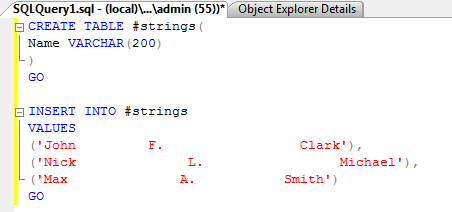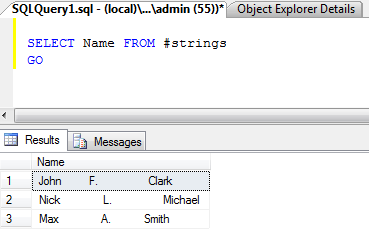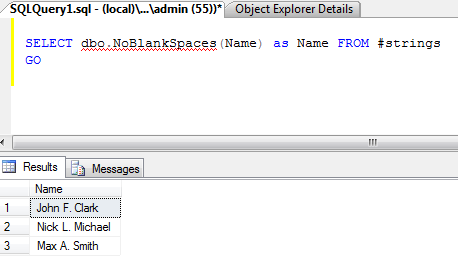In this article, we will be discussing about eliminating blank spaces in SQL Server table records and columns.
About Blank Spaces
Blank spaces always needed special handling in many programming languages.
This is not an exception in the case of the SQL programming language.
In SQL Server, a variety of built-in string functions exist for assisting, among other, the developer to solve data-related problems in the case of undesired blank spaces.
However, the blank spaces scenarios vary and sometimes it is necessary to use a combination of various built-in string functions for solving the problem.
Examples of Blank Space Scenarios
For example, consider having one or more columns within a record as the following:
An approach could be the following, using just the REPLACE built-in function like this:
Also, you could try this:
The above two approaches do not fully solve the problem of the specific blank spaces scenario.
As you can see, it started getting a little bit tricky regarding how it is possible to efficiently handle the specific blank spaces problem.
How you can Efficiently Handle Blank Spaces in SQL Server
Further below I am suggesting a workaround on how to resolve such issues.
To this end, first we need to create a sample data set with a column containing blank spaces:
As it will be too complex to include the logic within a single T-SQL statement, I preferred to create a function because it will be much easier to use it again in the future and the code looks more structured.
Here’s the DDL for my function:
--
--Function Name: NoBlankSpaces
--Purpose: Eliminate blank spaces (up to three words)
--Author: Artemakis Artemiou
--Input Parameter: Varchar(250)
--Output: Varchar(250)
--
CREATE FUNCTION [dbo].[NoBlankSpaces]
(
@string varchar(250)
)
RETURNS varchar(250)
AS
BEGIN
declare @part1 as varchar(100)
declare @part2 as varchar(100)
declare @part3 as varchar(100)
declare @part4 as varchar(100)
declare @temp as varchar(100)
set @part1=(rtrim(substring(@string,0,(charindex(' ',ltrim(@string))))))
set @temp=ltrim(substring(@string,(charindex(' ',@string)),len(@string)+1))
set @part2=SUBSTRING(@temp,0,CHARINDEX(' ',@temp))
set @temp=SUBSTRING(@temp,0,250)
set @part3=ltrim(SUBSTRING(@temp,CHARINDEX(' ',@temp),250))
set @string=rtrim(ltrim(@part1+' '+@part2+' '+@part3))
RETURN @string
END
GO
-------------End of Function DDL-----------------
As you can see in the above DDL code, I am using a combination of the SUBSTRING, LTRIM, RTRIM and the CHARINDEX SQL Server built-in string functions for achieving my goal.
Now, let’s use the function and see what the outcome will be:
Cool! No more blank spaces! 🙂
The combination of the SQL Server built-in functions worked great towards the solution of the blank spaces issue.
Learn essential SQL Server development tips! Enroll to our Online Course!
Check our online course titled “Essential SQL Server Development Tips for SQL Developers” (special limited-time discount included in link).
Sharpen your SQL Server database programming skills via a large set of tips on T-SQL and database development techniques. The course, among other, features over than 30 live demonstrations!

Featured Online Courses:
- Boost SQL Server Database Performance with In-Memory OLTP
- Essential SQL Server Administration Tips
- SQL Server Fundamentals – SQL Database for Beginners
- Essential SQL Server Development Tips for SQL Developers
- The Philosophy and Fundamentals of Computer Programming
- .NET Programming for Beginners – Windows Forms with C#
- Introduction to SQL Server Machine Learning Services
- Introduction to Azure SQL Database for Beginners
- SQL Server 2019: What’s New – New and Enhanced Features
- Entity Framework: Getting Started – Complete Beginners Guide
- How to Import and Export Data in SQL Server Databases
- Learn How to Install and Start Using SQL Server in 30 Mins
- A Guide on How to Start and Monetize a Successful Blog
Check our Related SQL Server Development Articles:
- The set identity_insert Command in SQL Server
- The Import Flat File Wizard in SSMS v17.3
- Listing all Tables of a Linked Server’s Database
- How to Import and Export Unstructured Data in SQL Server – FileTables
- How to Import and Export Unstructured Data in SQL Server – FILESTREAM
- How to Import and Export Unstructured Data in SQL Server – The IMAGE Datatype
- …more
Subscribe to our newsletter and stay up to date!
Check out our latest software releases!
Check our eBooks!
Rate this article:
Reference: SQLNetHub (https://www.sqlnethub.com)
© SQLNetHub
Artemakis Artemiou is a seasoned Senior Database and AI/Automation Architect with over 20 years of expertise in the IT industry. As a Certified Database, Cloud, and AI professional, he has been recognized as a thought leader, earning the prestigious Microsoft Data Platform MVP title for nine consecutive years (2009-2018). Driven by a passion for simplifying complex topics, Artemakis shares his expertise through articles, online courses, and speaking engagements. He empowers professionals around the globe to excel in Databases, Cloud, AI, Automation, and Software Development. Committed to innovation and education, Artemakis strives to make technology accessible and impactful for everyone.







Wouldn't it be simpler just to do this?
DECLARE @trimmed VARCHAR(255) ,
@LastTrimmed INT
SELECT @trimmed = 'this has too many spaces' ,
@LastTrimmed = 0
WHILE LEN(@Trimmed) <> @LastTrimmed
SELECT @LastTrimmed = LEN(@Trimmed) ,
@trimmed = REPLACE(@trimmed, ' ', ' ')
SELECT @Trimmed
Hi Phil,
Thank you for your comment.
It is always great to hear from fellow community members.
Your suggestion is very good. Of course you are using a WHILE loop which can be a little bit more expensive from a performance perspective but it is simpler.
Please note that if you try the following it won't work:
Image Link 1
Though, if you try this, yes it will work (add one more space in the REPLACE function parameter):
Image Link 2
And to be more correct and handle any preceding or following blank spaces, you can include to your code LTRIM and RTRIM:
Image Link 3
Cheers,
Artemakis
Somehow, the posting operation took out the second space from the first ' ' in the REPLACE function.(the second ' ' should have one space in it. It may be better to do them as Char(32)+Char(32), Char(32). It was cut/pasted straight from working code, but I couldn't edit it subsequently.
The Ltrim/Rtrim operation would be handy in some circumstances.
Yes, sometimes such things happen 🙂
Hi Artemakis,
the first came to my mind is actually similar to Phil's answer but more a little bit more concise
Solution 1:
while charindex(' ', @text) > 0 set @text = replace(@text, ' ', ' ')
where variable @text contains the string you wont to trim
declare @text varchar(255)
set @text = 'John F. Clark'
Note: Use rtrim and ltrim to remove trailing spaces for Solution 1
I agree with you, such a solution might take longer if you have a lot of spaces inside — in such cases you can use Solution 2.
Solution 2:
declare @index int, @temp varchar(255)
select @temp = '', @index = charindex(' ', @text)
while @index > 0
begin
set @temp = @temp + substring(@text, 1, @index)
set @text = ltrim(substring(@text, @index + 1, len(@text) – @index))
set @index = charindex(' ', @text)
end
set @text = @temp + @text
Hi Alexandre,
Thank you for your comment.
Yes, that's very correct. Your suggestion works for many (if not all) scenarios.
As we see there are many solutions to this issue, the important thing is to first analyze each case and decide which one of the available solutions should be used.
Cheers,
Artemakis
The simple version I've just added is safe for blocks of spaces up to 208 characters long, which should suffice. The huge advantage is its speed, as it requires no UDF to clean up text with space in it. uoi can addt LTRIM and RTRIM to taste
Hi Phil,
Unfortunately I cannot see the newly added code on the blog, I just received it via an email notification. Can you please repost it?
Thanks.
SELECT
REPLACE
(REPLACE
(REPLACE
(REPLACE
(REPLACE
(
'this has too many spaces' ,
REPLICATE(CHAR(32), 6),CHAR(32)),
REPLICATE(CHAR(32), 5), CHAR(32)),
REPLICATE(CHAR(32), 4), CHAR(32)),
REPLICATE(CHAR(32), 3), CHAR(32)),
REPLICATE(CHAR(32), 2), CHAR(32))
/* This version is safe for blocks of spaces up to 208 characters long, (38 if you miss out the replacement for six consecutive spaces, and 10 if you miss out both the five and six consecutive spaces) which should suffice.
The huge advantage is its speed, as it requires no UDF to clean up text with space in it.
Hi Phil,
I agree, this can be a solution too, and a fast one!
As I said in my previous comment, finally it depends on the case when it comes to which solution to use.
The good thing is that there are many solutions for different scenarios 🙂
Cheers,
Artemakis
how to find substring in a string
e.g raw material
in this string i want to extract First letter of raw n first letter of material….
Hi priyanka,
Check out my latest article (added today) – Requirement 3.
Cheers,
Artemakis